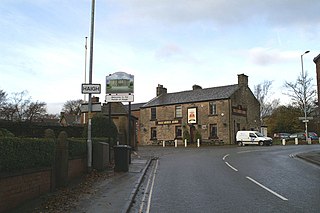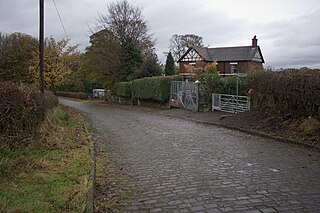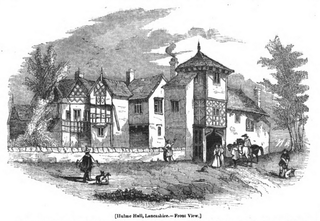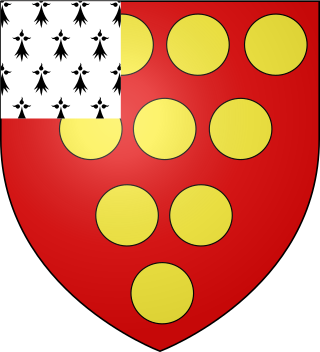Related Research Articles

Adlington is a village and civil parish in the Borough of Chorley in Lancashire, England, near the West Pennine Moors. It is 3 miles south of Chorley. It became a separate parish in 1842 then grew into a township around the textile and coal mining industries until these closed in the 1960s. It had a population of 5,270 at the 2001 census, and risen to 6,010 at the 2011 census. The Leeds and Liverpool Canal runs through the village and is host to White Bear Marina which is the largest marina on the Leeds and Liverpool Canal.

Whitefield is a town in the Metropolitan Borough of Bury, Greater Manchester, England. It lies on undulating ground above the Irwell Valley, along the south bank of the River Irwell, 3 miles (4.8 km) southeast of Bury, and 5 miles (8.0 km) northwest of Manchester. Prestwich and the M60 motorway lie just to the south.

Prestwich is a town in the Metropolitan Borough of Bury, Greater Manchester, England, 3 miles (4.8 km) north of Manchester, 3 miles (5 km) north of Salford and 5 miles (8.0 km) south of Bury.

Radcliffe is a market town in the Metropolitan Borough of Bury, Greater Manchester, England. It lies in the Irwell Valley 7 miles (11 km) northwest of Manchester and 3 miles (5 km) southwest of Bury and is contiguous with Whitefield to the south. The disused Manchester Bolton & Bury Canal bisects the town.

Haigh is a village and civil parish in the Metropolitan Borough of Wigan, Greater Manchester, England. Historically part of Lancashire, it is located next to the village of Aspull. The western boundary is the River Douglas, which separates the township from Wigan. To the north, a small brook running into the Douglas divides it from Blackrod. At the 2001 census it had a population of 594.

Robert de Holland, 1st Baron Holand was an English nobleman, born in Lancashire.

de Lacy is the surname of an old Norman family which originated from Lassy, Calvados. The family took part in the Norman Conquest of England and the later Norman invasion of Ireland. The name is first recorded for Hugh de Lacy (1020–1085). His sons, Walter and Ilbert, left Normandy and travelled to England with William the Conqueror. The awards of land by the Conqueror to the de Lacy sons led to two distinct branches of the family: the northern branch, centred on Blackburnshire and west Yorkshire was held by Ilbert's descendants; the southern branch of Marcher Lords, centred on Herefordshire and Shropshire, was held by Walter's descendants.

Prestwich-cum-Oldham was an ancient ecclesiastical parish of the hundred of Salford, within the historic county boundaries of Lancashire, England. With the Parish Church of St Mary the Virgin, Prestwich as its centre, this parish encompassed a total of ten townships, and within them, several smaller chapelries.

Unsworth is a village and residential area of the Metropolitan Borough of Bury, in Greater Manchester, England. The population of Unsworth Ward, as of the 2011 census is 9,492. The village sits approximately 7 miles (11 km) north of the city of Manchester and 4 miles (6.4 km) south of the town of Bury, and contains the area of Hollins, and part of Sunny Bank.

James Pilkington (1520–1576), was the first Protestant Bishop of Durham from 1561 until his death in 1576. He founded Rivington Grammar School and was an Elizabethan author and orator.

Agecroft Hall is a Tudor manor house and estate located at 4305 Sulgrave Road on the James River in the Windsor Farms neighborhood of Richmond, Virginia, United States. The manor house was built in the late 15th century, and was originally located in the Irwell Valley at Agecroft, Pendlebury, then in the historic county of Lancashire, England, but by the 20th century it was unoccupied and in a state of disrepair.

Stand is a residential area in Whitefield, Greater Manchester, England. The name is derived from a hunting stand, from which the surrounding countryside could be scanned for game.
The Manor of Rivington at Rivington in Lancashire, England was the past feudal means of control over land with manorial rights above and below ground. The manor history commences 1212 when the Pilkington family owned six oxgangs of land. Records are within a book Leverhulme sponsored, authored by William Fergusson Irvine using the same sources as an earlier work by Harland, the antiquarian who had inspected the Rivington Deeds and Documents, at Rivingon Hall in 1864. The manor was divided in moieties and in the 16th century the Pilkingtons of Rivington Hall owned a 5/8 share, the Cromptons who later occupied the Hall are reputed to have sold their share to William Hesketh Lever in 1900. Lever in turn agreed compensation for the majority of his freehold at Rivington from the Liverpool water company through the Liverpool Corporation Act 1902, the act makes no mention of the manor and there is no record of any later sale of manorial rights by Leverhulme or his heirs. Other owners of shares included a quarter owned in the past by the Lathoms of Irlam and an eighth owned by the Shaw family. The manor was not voluntarily registered under the Land Registration Act 2002 and resultingly no reference is made to it in modern title deeds. There are no manorial records at the National Archive.

The Pilkington family has its origins in the ancient township of Pilkington in the historic county of Lancashire, England. After about 1405 the family seat was Stand Old Hall which was built to replace Old Hall in Pilkington. The new hall was built on high land overlooking Pilkington's medieval deer park. Stand Old Hall was replaced by Stand Hall to the south in 1515 after the Pilkingtons were dispossessed. Stand Old Hall became a barn. It is possible that Sir Thomas Pilkington had permission to “embattle” his manor house in 1470 building a stone tower. It was a ruin by the 1950s and demolished in the early 1960s.

Hulme Hall was a manor house adjacent to the River Irwell in Hulme, Manchester, England. A structure of this name existed from at least the time of Henry II (1133–1189) until its demolition around 1840 during development related to the Bridgewater Canal. Owners included the Prestwich and the Mosley baronets prior to the property being bought from George Lloyd in 1764 by Francis Egerton, 3rd Duke of Bridgewater.

William la Zouche, 1st Baron Zouche (1276/86–1352), lord of the manor of Harringworth in Northamptonshire, was an English baron and soldier who fought in the Wars of Scottish Independence. He is referred to in history as "of Harringworth" to distinguish him from his first cousin Alan la Zouche, 1st Baron la Zouche (1267–1314) of Ashby de la Zouch in Leicestershire.

Outwood is a settlement in the Bury district in the county of Greater Manchester, England. Until 1974 it was in Lancashire.
Sir Nicholas Atherton (c.1357-1420) of Atherton. Other titles; Nicholas de Atherton, Lord of Bickerstaffe. English politician and Member of parliament (MP) of the Parliament of England for Lancashire in 1401. A lifelong member of affinity who was knighted on the 27 October 1400 in York, and prorogued on 20 January 1401 in Westminster. Born into a position within the Lancashire gentry. Extensive service to the House of Lancaster. Bailiff and medieval tax collector.
Sir John de Verdon was the 2nd son and eventual heir of Sir Thomas de Verdon, Lord of Brixworth in Northamptonshire and Bressingham in Norfolk, and his wife Margaret, daughter of Bewes otherwise Bogo de Knovill, 1st Baron Knovill. His main residence was initially at Bressingham, then later at Martlesham in Suffolk. In 1324, he was returned as a knight to attend the Great Council at Westminster. He is cited as being on the King's service in Aquitaine in June 1324. He was summoned to Parliament as a Baron by Writ 1331/1332, 1335/1336 and to the Great Councils in 1342 and 1347. In 1346, during the Crecy campaign, he served in the 1st Division under Prince of Wales 'the Black Prince', who gave him a destrier called Grisel de Coloign. However, illness necessitated his return to England sometime before 12 January 1346/7. In 1369 he attended Parliament as a Knight of Northamptonshire, although he had been created a Baron before then. He married firstly Agnes, and secondly Maud, the widow of Ralph de Crophull of Bonnington, Nottinghamshire, whose son Sir John de Crophull married Margery, daughter of Sir John de Verdon's kinsman, Theobald de Verdun, 2nd Baron Verdun of Alton Castle.
References
Notes
- 1 2 3 4 5 Brownbill & Farrer 1911 , pp. 88–92
- 1 2 Greater Manchester Gazetteer, Greater Manchester County Record Office, archived from the original on 18 July 2011, retrieved 17 June 2008
- ↑ Pilkington Township Map, genuki.org.uk, retrieved 27 June 2010
- 1 2 Horrox, Rosemary (2004), "Pilkington family (per. c.1325–c.1500), gentry", Oxford Dictionary of National Biography, Oxford University Press, retrieved 27 June 2010(subscription required)
Bibliography
- Brownbill, John; Farrer, William (1911), A History of the County of Lancaster: Volume 5, Victoria County History, ISBN 978-0-7129-1055-2